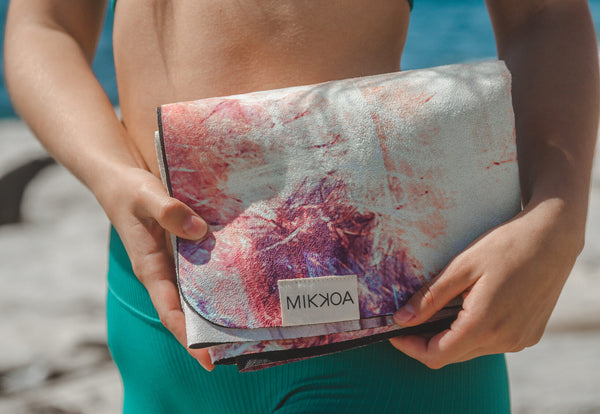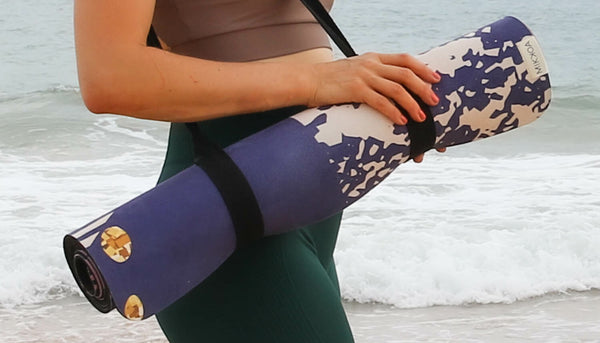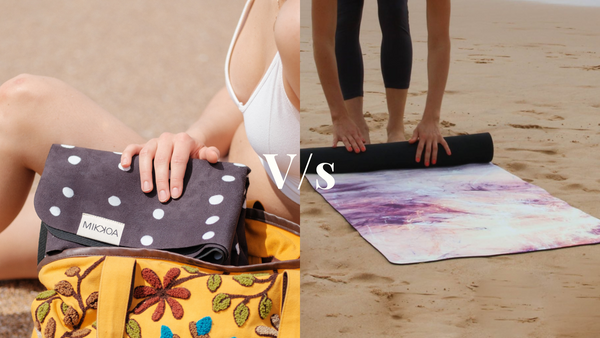What is Foldable Yoga Mat?

A foldable yoga mat is a type of yoga mat that is designed to be easily folded into a smaller, compact size for convenient storage or portability. It typically consists of multiple panels or segments that can be folded and unfolded as needed.
Foldable yoga mats are made from various materials such as natural rubber, synthetic rubber, or foam, and they often have a non-slip surface to provide stability during yoga practice. They are designed to be lightweight and easy to carry, making them suitable for travel or for people who frequently practice yoga on the go.
When not in use, a foldable yoga mat can be folded and stored in a bag or even a drawer, taking up less space compared to traditional rollable mats. Some foldable mats come with straps or handles for easy carrying, and they may also include additional features like antimicrobial properties or cushioning for enhanced comfort.
Overall, foldable yoga mats offer convenience and versatility, allowing practitioners to easily transport and store their mats without sacrificing quality or functionality.
What is Rolling Yoga Mat?

A rolling yoga mat refers to a type of yoga mat that is designed to be rolled up into a cylindrical shape for storage or transport. It is typically made from a single piece of material, such as rubber, PVC, or foam, which can be rolled tightly and secured with straps or ties.
It’s important to note that rolling mats may not be as compact or portable as foldable mats, especially if you need to carry them in a bag or while travelling. However, they are still relatively easy to transport and offer convenience for regular yoga practice at home or in a studio.
When selecting a rolling yoga mat, consider factors such as thickness, material, grip, and any additional features that align with your specific needs and preferences.
What is the difference between rolling and folding yoga mats?

Rolling and folding are two common methods of storing yoga mats, and they have some key differences:
| Functionality | Foldable | Rollable |
| Storage | Foldable mats take up less storage space compared to traditional rollable mats. They can be easily folded and stored in a drawer, closet, or small storage area when not in use. This is particularly useful if you have limited space at home or in your yoga studio. | Rolled mats take up more space as compared to the foldable yoga mats, usually you need to roll them up and keep them in closets, bags, or yoga mat holders. |
| Portability | Foldable yoga mats are designed to be lightweight and easy to carry. They can be folded into a compact size, making them convenient for travel or taking yoga classes. You can easily fit them into a backpack, suitcase, or gym bag without taking up much space. | Rollable mats, on the other hand, can be bulkier when rolled up, which may make them slightly less portable compared to foldable mats. However, the portability may still depend on the specific design and thickness of the mat. |
| Versatility | Foldable mats can be used for various forms of exercise beyond yoga, such as Pilates, stretching, or floor exercises. Their compact size and easy portability make them a versatile fitness accessory that can be used in different environments and settings. | Rolling mats are suitable for various types of yoga practice and other floor exercises. They provide a stable and comfortable surface for stretching, balancing, and performing yoga poses, making them versatile for different styles and levels of yoga. |
|
Material
|
Some foldable yoga mats are made from eco-friendly materials which are biodegradable, such as Natural Rubber or Polymer Environmental Resin. If you are conscious about minimizing your environmental footprint, you can choose a foldable mat that aligns with your values. | Many rollable yoga mats are made from eco-friendly materials such as natural rubber, cork, jute, hemp, mesh, cork or recycled materials, which are biodegradable and have a lower impact on the environment compared to mats made from synthetic materials like PVC or Polyvinyl. There are various options available in the market that are specifically designed to be environmentally friendly. |
| Stability & Grip | Foldable yoga mats can vary in terms of stability and grip, depending on the specific design, texture and materials used. While some foldable mats offer good stability and grip, others may not provide the same level of performance as traditional non-foldable mats. | Rolling mats are designed to offer a good grip, allowing you to maintain traction and prevent your hands or feet from slipping during exercises, ensuring that you can perform your activities with confidence and reduce the risk of injury. |
| Durability | Foldable yoga mats are typically made from durable materials such as Natural rubber, Microfiber Suede, TPE. They are designed to withstand regular use and provide good traction and support during yoga practice. | Rolling mats are often made from durable materials such as rubber, PVC, Foam, Cork, Microfiber, Terry Cloth, Jute or Hemp. They are designed to withstand regular use and provide good traction, stability, and support during yoga exercises. Their solid construction and resistance to wear and tear ensure long-lasting performance. |
| Maintenance | Foldable mats are generally easy to clean and maintain. Most of them can be wiped down with a damp cloth or sprayed with a gentle yoga mat cleaner to remove dirt and sweat. Some foldable mats are even machine washable for added convenience. | Rolling mats are usually made of materials like Rubber, Vinyl, Microfiber and PVC like Mikkoa, Gaiam, Lululemon, Manduka which are easy to clean. You can use a mild soap or mat cleaner with water to wipe down the surface of the mat. Make sure to dry it thoroughly before rolling it back up to prevent moisture buildup and mold growth. |
Ultimately, the choice to use a yoga mat depends on your specific needs and preferences. It’s important to consider factors such as thickness, material, grip, and any additional features when selecting a yoga mat. These factors can impact your comfort, stability, and overall yoga experience. Choose a mat that suits your specific needs and preferences to enhance your practice.
Some mats may be more suitable for rolling, while others might fold more easily without damage. Consider the type and thickness of your mat when deciding how to store it, and make sure to follow any specific instructions provided by the yoga mat manufacturer.

